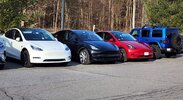Here is the factory charger layout. V2 at the top with 2 pedestals per stall so they can be accessed from either side without affecting the other adjacent stalls. V3 at the bottom where they only did 1 pedestal per stall so all vehicles have to enter from the left. Technically there are 100 chargers (72 V2, 28V3) but only 36 of the V2 are usable so each parking space has access to the full 150kw from its cabinet.
View attachment 933150
Whether you install double the amount of posts as parking stalls or lose half the amount of stalls due to non-Tesla standard charge port layouts, the result is the same. Only half of a site is usable. One is just less frustrating to users because you will never pull into a spot and find it unusable. "V4" might help things but I still think the cables are too short to reach all ports. Placing in the center back of each stall with the longer cords should alleviate many of the problems as all ports should be within 10 feet of the front or back of the vehicle.
To bring this back to Newark, I think this is 24 stalls. There are 12 in a row at the front of the picture, then another row of 5 or so at the end and 3 back in to the left with more (4?) pedestal bases uninstalled. This will be in additional to the two Destination Chargers (and two Clipper Creek J1772) already on site.
View attachment 933152





